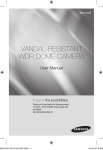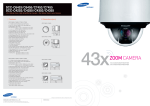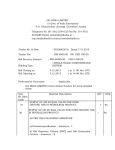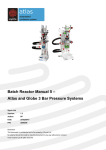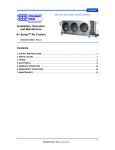Download ANHYDRATOR INSTALLATION AND OPERATION
Transcript
ANHYDRATOR INSTALLATION AND OPERATION BULLETIN ANH-SB07b SERVICE BULLETIN VALVES • VESSELS • SYSTEMS • CONTROLS System drawings shown in this bulletin are for illustration purposes only. Refrigeration systems should only be serviced by a qualified technician. Always observe proper safety procedures when servicing a refrigeration system. For more information see the latest revision of Phillips Safety Bulletin SGRV. GENERAL INFORMATION Pressure Rating: 300 psig (21 bar, gauge) Approximate Weight: Bare Unit: 375 lb (170 kg) Unit with Valves: 450 lb (205 kg) Heat Transfer Rate*: 6 Tons (21 kW) at 135°F (75°C) DT collected in the Anhydrator ultimately becomes a mixture of up to about 70% water, 30% ammonia, and other impurities. (It is not practical to remove all the ammonia from the water.) These impurities are drained from the bottom of the unit and disposed of according to local regulations. PURE AMMONIA TO SUCTION ACCUMULATOR *The Anhydrator does not impose a heat load on the refrigeration system. The stated Heat Transfer Rate is useful for estimating how quickly cold liquid vaporizes to separate impurities. The Phillips Anhydrator operates as a self-regulating still to remove water, oil, and other impurities from ammonia. Because the unit uses heat from high pressure liquid, thereby subcooling it, the unit is essentially energy-neutral. Because of its unique self-regulating capability, the unit can be allowed to run indefinitely without draining the accumulated impurities until a time that is convenient for the operator. Installing the Anhydrator as outlined in this bulletin will ensure low system operating costs with minimal maintenance. Inside the Anhydrator, cold impure liquid ammonia (typically taken from the pump discharge) is exposed to heat from the high pressure receiver liquid. (Refer to Figure 1.) The warm and cold streams do not mix. The cold impure liquid ammonia boils, and the resulting pure ammonia vapor is returned to the pump accumulator. After giving up some of its heat, the liquid from the high pressure receiver also goes to the pump accumulator. Because this liquid is now subcooled, the reduction in flash gas at the accumulator roughly balances with the pure ammonia vapor mentioned earlier. Depending on the system, the liquid AMMONIA & CONTAMINANTS FROM SUCTION ACCUMULATOR HP LIQUID SUPPLY TO SYSTEM LIQUID FROM HP RECEIVER WATER & CONTAMINANTS OUT Figure 1: Flow through the Anhydrator (Unit shown with 300HM Float Valve) INSTALLATION The Anhydrator should be located in an area with adequate ventilation for safe draining, as described later in this bulletin. Also, the HP liquid line should never include two isolation valves that could trap the liquid inside the Anhydrator (figure 3). On systems with liquid lines larger than 1", the Anhydrator may be supplied with by-passed warm liquid in the manner shown in figure 4. ANH-SB07b DRY SUCTION S TO EVAPORATORS CONTAMINATED LP LIQUID SUB-COOLED HP LIQUID Figure 2 is an example of how the Anhydrator may be integrated into a basic liquid recirculation system. Here, a small amount of contaminated liquid is taken intermittently from just downstream of the pumps. The ammonia vaporized in the Anhydrator returns to the accumulator, while the impurities are left behind. Although the Anhydrator’s self-regulation prevents liquid from returning through the vapor connection due to boil-over, attaching the vapor outlet to the accumulator or a wet suction line provides an extra measure of safety against a component malfunction. WET SUCTION PURE NH3 VAPOR Inside an ammonia system, water travels with liquid ammonia and accumulates in locations like pump accumulators and flooded chillers. Connecting the Anhydrator to these locations allows water and other contaminants to be safely and effectively removed. HP LIQUID ANHYDRATOR Figure 2: Basic Anhydrator Installation 1 WET SUCTION DRY SUCTION S TO EVAPORATORS CONTAMINATED LP LIQUID SUB-COOLED HP LIQUID Although the warm liquid from the high pressure receiver has been subcooled by the economizer, there will still be sufficient heat to boil cold liquid. In the event of sudden system changes affecting the flow of the warm liquid, the self-regulating characteristics of the Anhydrator will prevent surges of impurities back to the system through the top vapor connection. Note that some means should be provided for switching the source of contaminated liquid between the economizer and the pump discharge. Anhydrators are available without valves, with valves shipped loose, or assembled with valves. Consequently, the actual field configuration will vary. However figure 7 shows recommendations for a typical installation. It is suggested that the top portion of the Anhydrator should be covered with 3” thick insulation, down to the level of the lower elliptical head. The level-indicator tube should be left uncovered. PURE NH3 VAPOR Because water can also collect inside “closed-coil” (i.e., shell-and-tube or shell-and-coil) economizers, provisions should be made to connect them to the Anhydrator as well. (Flash economizers need not be connected to the Anhydrator.) Figure 5 shows one way that this can be accomplished. ECONOMIZER Flooded chillers will accumulate water in the same way as economizers. Consequently, they too should be connected to the Anhydrator. System configurations vary, but Figure 6 is one example to illustrate how this can be done. Note that when the cold liquid is not from the pump discharge or other high pressure source, the float valve on the Anhydrator must be at a lower elevation than the source of the liquid. HP LIQUID CONTAMINATED LP LIQUID Figure 5: Anhydrator used with Economizer SUCTION NOTE: DO NOT INSTALL STOP VALVES THAT COULD TRAP HP LIQUID IN THE ANHYDRATOR. The HP line inside the Anhydrator has no pressure relief to prevent rupture. SUB-COOLED HP LIQUID FLOODED CHILLER SUB-COOLED HP LIQUID PURE NH3 VAPOR CONTAMINATED LP LIQUID HP LIQUID ANHYDRATOR HP LIQUID Figure 3: Never Trap HP Liquid HP LIQUID MAIN Figure 6: Anhydrator used with Flooded Chiller 2 PSID RESTRICTION Figure 4: Installation on Larger Systems ANH-SB07b Cold contaminated liquid enters the Anhydrator through a ½” FPT connection on the float valve. The purified ammonia vapor is routed to the pump accumulator or wet suction through a 2” line. Warm liquid from the high pressure receiver (or economizer) enters through a 1” connection on the bottom of the Anhydrator. It leaves the unit through a second 1” connection, after becoming sub-cooled, and flows to the pump accumulator or flooded chiller. Water and other impurities separated from the ammonia are drained from the unit through a valve at the bottom of the unit. Because water and other impurities will be flowing through it, it is recommended that a stainless steel ball valve be connected directly to the drain connection. A globe valve will also serve, but with reduced reliability. Also many ball valves are of flanged construction, permitting disassembly to clear debris. A spring loaded, self-closing drain valve should be installed after the ball or globe valve, similar to those recommended for oil pot drains. Note that in the event that liquid ammonia is trapped in the pipe above the drain valve, a self-relieving feature will prevent hydrostatic rupture. But in this case, the discharge of the dead man valve should not be capped. 2 OPERATION LOWER PORTION NOT TO BE INSULATED LEVEL INDICATOR TUBE Figure 7: Anhydrator, shown assembled with optional valves Initial Start-Up 1. 2. 3. 4. With warm liquid flowing through the 1” lines at the bottom of the unit, • Close the 2” valve at the top of the unit, • Close the 1/2” hand valve upstream of the filter, and • Close the 1” valve on the bottom of the unit. Draw a vacuum inside the unit through the ¼” FPT service connection near the top of the unit. Open the 2” valve to suction. Open the 1/2” hand valve, allowing liquid to flow into the Anhydrator. Frost should begin to form on the level indicator tube as the liquid level inside the unit rises. Pure ammonia is now boiling to a vapor and returning to the pump separator. Water, oil, and other impurities are trapped in the Anhydrator. Allow the unit to run until the frost is melting above the 1” drain valve and on the oil sump portion of the unit. This indicates that a significant amount of water, oil and other impurities have been collected. (The time required before this happens depends on the quantity of impurities present in the system.) Guidelines for draining the unit are given below. There is no danger in allowing the impurities to collect indefinitely. They will be trapped inside the Anhydrator where they cannot affect system operation. However, it is recommended that initially the Anhydrator be drained on a monthly basis to assess the level of system contamination. Thereafter, the unit should be drained every three months. Draining SAFETY: Draining impurities from the Anhydrator is similar to draining an oil pot. Consequently the procedure is potentially dangerous and should only be performed by properly trained personnel. Further information can be found in the IIAR Recommended Oil Draining Guidelines. The Anhydrator should never be drained before it has been properly isolated from the system and pumped down. Personnel should be familiar with: • The exact procedure for isolating and draining the unit (given below) • Emergency response procedures • The location of the nearest eyewash/shower station • The location of all valves that would be required to further isolate the unit in the event of a problem • Ammonia first aid procedures • Lockout/tag procedures ANH-SB07b Personnel should wear proper safety apparel including, but not limited to: • Elbow-length rubber gloves • Splash goggles • Face shield In addition, check the ventilation fans in the area. Be sure they are operating. 3 Draining (Continued) SAFETY NOTES: Remain in position at the Anhydrator and keep a vigilant watch for the duration of the draining process. Never disable the self-closing feature of the “dead-man” valve. Never apply direct heat to the Anhydrator to speed up the pump-down or draining process. 1. 2. 3. Close the 1/2” hand valve upstream of the filter. Allow the unit to run until the bottom portion of the unit is nearly clear of frost. Allow the unit to run at least an additional 60 minutes. Heat from the warm liquid ensures that ammonia mixed with the impurities (which will be drained) is minimal. BE SURE THE ANHYDRATOR HAS BEEN INSTALLED WITH A PRESSURE RELIEF VALVE BEFORE PROCEDING. Close the 2” valve at the top of the unit. Place bucket under drain valve. If the system operates at a vacuum, wait for pressure to rise to a positive value. 7. Open the 1” valve at the bottom of the unit. 8. Open the quick-closing drain valve at the bottom of the unit and allow liquid (oil, water, some ammonia) to begin to drain into a bucket. A strong odor of ammonia will be apparent and is normal. However, if the odor is overwhelming, immediately stop draining, close drain valves, and open 2” suction valve. Allow the unit to pump down for an additional 60 minutes. (Return to steps 3 & 4, above.) 9. Drain 2 - 4 gallons of liquid into a bucket. 10. Close the quick-closing drain valve 11. Close the 1” valve. 12. Dispose of the drained liquid per established procedures and in accordance with local regulations. TROUBLESHOOTING CONDITION: Frost line on level indicator tube moves up and down slightly Liquid level shown in float valve chamber sight glass sometimes shows high liquid level. Level indicator tube never frosts-up completely 4. 5. 6. SAFETY NOTES: If the quick-closing drain valve does not have a selfrelieving feature, clear the pipe between the ball valve and drain valve of liquid by opening the drain valve briefly after closing the ball valve. (Otherwise trapped liquid could lead to hydrostatic rupture.) If the quick closing drain valve does have a self-relieving feature, capping the valve outlet could lead to trapped liquid, causing hydrostatic rupture. Be sure to read the valve manufacturer’s literature for recommendations before capping the outlet. Re-starting the Unit 1. 2. Level indicator tube never clears completely of frost Liquid flood-back to the system Liquid fails to drain when the quickclosing drain valve is opened. CAUSE / SOLUTION This is normal during operation. The unit’s internal components allow the liquid level to move in response to changing system conditions. This is normal during operation. The unit’s internal components allow the liquid level to move up and down in response to changing system conditions. However if the liquid level is always high, it indicates a possible malfunction of the float valve. Troubleshoot float valve according to that component’s service manual. • Insufficient flow into unit: 1. On gravity-fed applications, be sure the float valve elevation is lower than the source liquid level 2. Check if 1/2” globe valve is completely open or if strainer is blocked with oil, debris. 3. Check if float valve is operating properly. • Suction temperature is above 32°F. • Lower end of indicator tube is clogged with oil. Drain oil per normal draining procedures. This is normal during operation, but during pump-down the frost should clear. The presence of frost indicates a high concentration of ammonia remains in the unit. Float valve may be malfunctioning. Troubleshoot float valve according to that component’s service manual. • Ensure that the 1” valve above the spring-loaded valve is open. • Check the pressure gauge at the service connection. A deep vacuum (10” to14” Hg) may prevent flow, especially if a thick layer of oil exists. With the unit still isolated, monitor the pressure and attempt draining again when the pressure rises to 0 psig or higher. • Spring-loaded drain valve may be clogged with debris. Close 1” drain valve, remove and clean spring-loaded valve. Open the 2” valve at the top of the unit. Open the 1/2” hand valve and allow the unit to re-fill. H. A. Phillips & Co. 1612 Louise Drive South Elgin, Illinois 60177-2242 • U.S.A. Phone: (630) 377-0050 • Fax: (630) 377-2706 E-mail: [email protected], or visit us at www.haphillips.com ANH-SB07b 4




